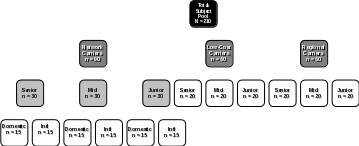2120-Flight Attendant Field Study_Emergency_B
2120-Flight Attendant Field Study_Emergency_B.doc
National Flight Attendant Duty/Rest/Fatigue Field Study
OMB: 2120-0736
B. Statistical Methods
1. Describe the potential respondent universe.
The total respondent universe consists of all U.S. flight attendants currently employed as an active flight attendant for a U.S. air carrier (i.e., not furloughed). Since the number of flight attendants employed by U.S. air carriers varies by month, we can only estimate the number of flight attendants that will be employed at the time of distribution with the 2006 and 2004 Bureau of Transportation Statistics records. Using these numbers as a baseline, we are estimating the total population of respondents will equal approximately 100,000 flight attendants from approximately 30 different air carriers.
2. Describe the procedures for the collection of information.
Several sources of data will be collected to capture the quantity and quality of sleep obtained on and off duty and its affect on subjective experience and cognitive performance:
Sleep/Activity Patterns (wrist worn Sleep Band): continuously, 24-hours per day across protocol period (30-days)
Psychomotor Vigilance Task (PVT):
Both duty and non-duty days: performed ~1 hr before duty and ~1 hr following duty; and 45 min after rising from major sleep period and just before going to bed on non-duty days
Daily Log books: 1x per day (~5 min) throughout the protocol period (30-days)
Subjective Ratings: beginning and end of each duty period
Voice Records: Obtained during the same time-frame as the PVT is conducted
Workload (Pedometer): continuously throughout the scheduled flight operation
A total of 210 flight attendants will be recruited for voluntary participation in the study for a period of no more than 30 consecutive days. Although efforts will be made to recruit an equal number of female and male volunteers, the majority of the flight attendant population is female. Therefore, efforts will be made to recruit a representative sample of flight attendants as determined by current labor statistics. Prospective volunteers will not be systematically excluded based solely on age or ethnicity. Individuals selected for participation from the pool of applicants will be contacted and briefed in real-time by a member of the research staff, who will thoroughly explain the purpose of the project, the procedures involved, and the potential risks and benefits of participation. If the individual still wishes to participate, a member of the research staff will furnish a copy of the Informed Consent form, explain it to the volunteer, and answer any additional questions before asking him/her to sign the form.
The final participant pool will represent a cross-section of the US flight attendant population, including members of participating Network, Low-Cost, and Regional carriers of senior, mid-level, and junior seniority status engaged in domestic and international flights:

Volunteer participants will receive no less than $400 US from IBR for completing the entire course of the project ($11.66 per day x 30 days + $50 study completion bonus). As described in the Consent Form, all participants are free to withdraw from the study at any time and for any reason. Individual participants may also be removed from the study by the project research staff for safety reasons, compromised ability to perform regular work duties, changes in health status, changes in legal status, disruptive or inappropriate behavior, or non-compliance with the research protocol. Individuals who choose to withdraw or are removed from the study before completing the final duty cycle of their respective 30-day study period will receive no less than $11.66 US per day for each day of participation.
In order to ensure anonymity, individual participants will be assigned a number in the database, and all data will be de-identified in all databases used for analysis and reporting. Only persons directly involved with the research will have access to the raw data, and under no circumstances, will any individually identifiable data be published or made available to persons not directly associated with the research without explicit, prior written approval from the individual(s) in question. Employers will not have access to any individually identifiable data.
3. Describe methods to maximize response rates.
The data collection will be conducted from November 2008 through March 2009. Invitation to Participate letters will be sent to approximately 30,000 randomly selected flight attendants via email. Since this study involves payment for participation, we anticipate a very high rate of interest. We will select 210 for participation, based on the criteria described in section B2 above.
4. Describe tests of procedures and methods to be undertaken.
All instruments were reviewed by a group of experienced FAA researchers and Flight Standards Service (AFS-200) personnel for clarity of instructions and technical details. The methodology has been successfully employed by several airlines demonstrating the efficacy of fatigue countermeasures deployed on ultra long range flights (i.e., flight times >16 hr).
5. Provide the names of consultants and the person who will collect and analyze the information.
FAA CAMI:
Thomas Chidester, Ph.D.
Carla Hackworth, Ph.D.
Thomas E. Nesthus, Ph.D.
Andrew Mead, Ph.D.
Katrina Avers, Ph.D.
Grantees:
Institutes for Behavior Resources, Human Performance Center:
Steven R. Hursh, Ph.D.
Melissa M. Mallis, Ph.D.
Peter G. Roma, Ph.D.
Subcontractors to Grantee:
Archinoetics, LLC
John A. Caldwell, Ph.D.
Hunter Downs, Ph.D.
Response Applications, LLC
Hal Greeley, Ph.D.
| File Type | application/msword |
| Author | Taylor CTR Dahl |
| Last Modified By | Taylor CTR Dahl |
| File Modified | 2008-09-15 |
| File Created | 2008-09-15 |
© 2025 OMB.report | Privacy Policy